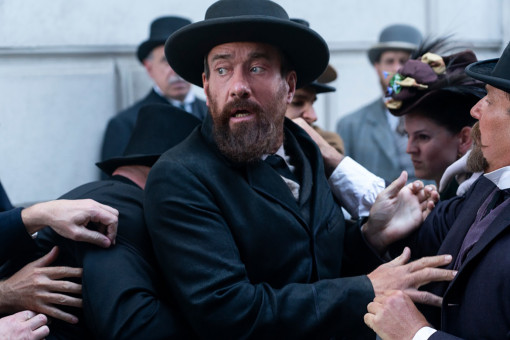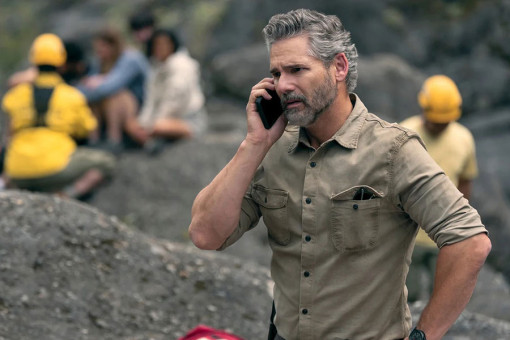In writer-director Steven Zaillian’s Ripley, the only witnesses to the titular sociopath-turned-murderer — played with unsettling sangfroid by Andrew Scott — are silent ones. And, like everything else in Netflix’s captivating, eight-episode thriller, that was by design.
“Steve was very well organized, and thoughtful,” says Ripley’s Oscar-winning cinematographer, Robert Elswit (There Will Be Blood). He planned out how he wanted Tom Ripley’s world to appear and feel.” The world of the latest adaptation of novelist Patricia Highsmith’s 1955 thriller The Talented Mr. Ripley is one where old Italian statues, perched above cobblestone streets like weather-beaten gargoyles, observe both Tom’s violent crimes and their haunting (and high-intensity) aftermath — and they do so in stark, black and-white courtesy of Zaillian and his DP’s desire to put Ripley’s murderous sojourn in Italy through a very noir, Fellini-esque lens. The black and white cinescape is a sly visual counterpoint to the story, given the moral and ethical grays that Tom traffics in.
But the sole instance of color in Ripley’s monochromatic world, that of (naturally) red blood, is relegated to another eye witness that cannot speak: Lucio, the curious cat belonging to the landlady who Tom takes a liking to when, posing as his first victim, former friend Dickie Greenleaf (Johnny Flynn), rents a lavish apartment in her building. Lucio quietly watches Tom drag his second victim — Dickie’s friend, Freddie Miles (Eliot Sumner) — down a long flight of unforgiving stairs and out of the building. The feline voyeur leaves a trail of bloody paw prints after stepping in some of Freddie’s blood, which the viewer sees in all its crimson glory. That visual, however, was not in Zaillian’s initial design.
“That was done in post,” Elswit explains. “Steve ultimately makes the final decision, but maybe one of his editors said, ‘What about this…?’ But I bet it was Steve. It was such a clever idea.”
Equally clever, and extremely more complicated, was how Elswit and his crew planned to shoot Freddie’s slow-burn demise and the subsequent disposal of his body in the fifth episode. After Freddie recognizes that Tom is wearing Dickie’s Ferragamo shoes and pieces together that something nefarious has happened to his pal — whose life Tom has now appropriated — Tom strikes Freddie’s skull with an antique glass ashtray. The logistics of how to film and frame in-camera this fatal bludgeoning for maximum (no pun intended) impact required Elswit to get inventive.
“It was one of those things where we were like: How do we hit him without seeing it exactly? And how do we make it work? So this idea of Freddie opening the door [to the apartment] and timing that just about a second after Tom has hit him in the head, I think that grew out of little planning sessions while we were there [on set].”
But what fascinated Zaillian more than the show’s actual kills, according to Elswit, is what happens next. In the instance of Freddie, Elswit says they “spent an enormous amount of time getting rid of Freddie, almost as much time as getting rid of Dickie.” [Editor’s note: The third episode devotes a lengthy set piece to the disposal of Dickie’s body after a small boat trip with Tom goes horribly wrong for both victim and killer.]
The time spent on the disposing of Freddie's corpse in what could fittingly be called the dead of night, out in the open, generates significant white-knuckle tension for the viewer — thanks in part to the set design, which was based on a real apartment the production found while on location in Italy. “A lot of the way the set was designed by the wonderful David Gropman, who built Dickie’s apartment on stage, went toward how we shot the scene and found all those wonderful, tense bits of business,” Elswit recalls. “The planning of that sequence was something [Zaillian] laid out very carefully in his mind.” Dickie’s apartment — and that of Tom Ripley's —were built on a stage. Also built was the landing and the elevator shaft, which runs down the middle of the building.
“The real location had exactly that same elevator and that door and that landing,” Elswit explains. “But the interior of the apartment [that we built] was completely different. You could get in the elevator, but you couldn't go anywhere. So, when we're looking towards the elevator, we're on location. We're in the beautiful palazzo that belonged to the family that allowed us to use it. It used to be a family home, one of these 16th-century palazzos that they have all over Rome, that they then turned into apartments.”
The logistics of both the real location and its on-set facsimile required careful planning — especially on a television shooting schedule in the middle of the Covid pandemic. (Ripley filmed in 2021). “We weren’t making it up as we went along,” Elswit says. “We’d occasionally find things like this shot or that shot, or we’d change an image slightly or maybe have to invent something on the day.”
One memorable beat the production discovered on the day was the darkly comedic moment where Freddie’s limp head bounces and thunks slightly as Tom drags the body down the stairs. “Freddie’s head bouncing, that wasn’t scripted,” he says. “We had an incredible dummy made [to look like Sumner]. So, after Freddie is dragged down to the street and he sits there on the ground and Tom goes through all his pockets, sometimes that’s really Eliot and sometimes it’s the dummy. But Eliot, they were incredibly patient. They would have to sit there and hold their breath.”
Audiences also hold their breath, when they aren’t gasping, while watching another one of Tom Ripley’s homicides in almost real-time. The end result is a harrowing, haunting look at the lengths to which a man like Tom will go to ensure that, to paraphrase the 1999 Talented Mr. Ripley film, that he stays a “fake somebody rather than a real nobody.”
“It's just part of Steven's fascination with Highsmith,” Elswit says. “The way she wrote it, and getting a sense of who this character is, and how you feel watching him. We couldn’t have done it without a fantastic production team.”
Ripley is now streaming on Netflix.
















